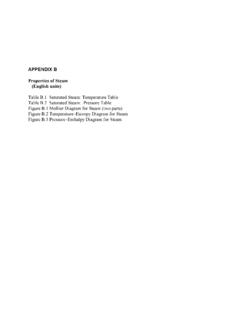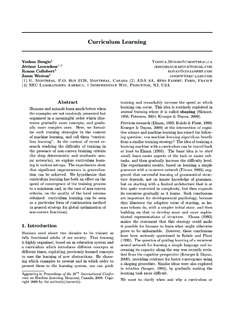Transcription of Food Safety Programs for Food Service to Vulnerable Persons
1 food Safety Programs for food Service to Vulnerable Persons A guide to Standard food Safety Programs for food Service to Vulnerable Persons Chapter 3 of the Australia New Zealand food Standards Code (Australia Only). February 2008. food Standards Australia New Zealand Australia PO Box 7186 Canberra BC. ACT 2610. Australia Tel: +61 2 6271 2241 Fax: +61 2 6271 2278 food Safety Programs for food Service to Vulnerable Persons A guide to Standard food Safety Programs for food Service to Vulnerable Persons Chapter 3 of the Australia New Zealand food Standards Code (Australia only). First edition, February 2008. food Standards Australia New Zealand Canberra II food STANDARDS AUSTRALIA NEW ZEALAND. food Safety Programs FOR food Service TO Vulnerable Persons . food Standards Australia New Zealand 2008. ISBN 978-0-642-34558-5. Published on the food Standards Australia New Zealand website This work is copyright. Apart from any use as permitted under the Copyright Act 1968, no part may be reproduced by any process without prior written permission from food Standards Australia New Zealand.
2 Requests and inquiries concerning reproduction and rights should be addressed to the Information Officer, food Standards Australia New Zealand, PO Box 7168, Canberra BC, ACT 2610. food Standards Australia New Zealand Australia: PO Box 7186. Canberra BC ACT 2610. Australia Tel: +61 2 6271 2222. Fax: +61 2 6271 2278. Email: New Zealand: PO Box 10559. The Terrace Wellington 6036. New Zealand Tel: +64 4 473 9942. Fax: +64 4 473 9855. Email: GUIDE TO STANDARD food STANDARDS AUSTRALIA NEW ZEALAND CONTENTS III. food Safety Programs FOR food Service TO Vulnerable Persons . Contents Introduction 1. What is the purpose of the guide? 1. What is the scope of the guide? 1. Is the information in this guide legally binding? 1. Can I provide feedback on this guide? 1. How do I use this guide? 2. Background 3. Why was Standard developed? 3. What is Standard 3. What are Chapter 3 food Safety standards? 4. Which food businesses are required by Standard to comply with Standard food Safety Programs and by when?
3 4. Standard food Safety Programs for food Service to Vulnerable Persons 7. Clause-by-clause explanation of Standard 13. Introduction to the standard 13. 2 Interpretation 13. 1 Application 18. 3 food Safety Programs 27. Schedule 34. Appendix 1 Standard food Safety Programs 41. Appendix 2 Further examples illustrating the application (or not). of subclause 1(1) to food businesses 44. Appendix 3 food Safety program tools 46. Glossary of terms 47. AUSTRALIA NEW ZEALAND food STANDARDS CODE CHAPTER 3 (AUSTRALIA ONLY). IV food STANDARDS AUSTRALIA NEW ZEALAND. food Safety Programs FOR food Service TO Vulnerable Persons . GUIDE TO STANDARD food STANDARDS AUSTRALIA NEW ZEALAND INTRODUCTION 1. food Safety Programs FOR food Service TO Vulnerable Persons . Introduction What is the purpose of the guide? The guide to Standard food Safety Programs for food Service to Vulnerable Persons is intended to help those people responsible for enforcing the Australia New Zealand food Standards Code (the Code) to understand the intent of the clauses contained in Standard It has been developed by food Standards Australia New Zealand (FSANZ) in accordance with section 13(1)(c).
4 Of the food Standards Australia New Zealand Act 1991. The entire Code is available on the FSANZ. website at What is the scope of the guide? The guide has been developed to help enforcement officers understand the general intent of individual clauses in Standard It does this by providing an explanation of the legally defined terms and requirements in each clause as well as by including examples, where appropriate. The aim is to clarify to which food businesses Standard applies and, therefore, which businesses are required to have food Safety Programs . This guide does not provide specific guidance on how businesses should develop and implement food Safety Programs . A range of tools, templates and guides developed by the Australian Government and individual state and territory food authorities can be referenced by those seeking further guidance on Standard food Safety Programs (see Appendix 3 for information on how to obtain this guidance material). Is the information in this guide legally binding?
5 The guidance provided in this document is not legally binding only the clauses in the standard are legally binding. Persons who are uncertain about the meaning of a clause in Standard can refer to the explanation in this guide for clarification. The guide includes examples where these may be helpful in explaining the meaning of a clause. However, neither the explanations in the guide nor the examples are legal requirements for food businesses. As this standard forms only a part of Australian food legislation, state, territory and enforcement officers should also refer to other standards in the Code and to their state's or territory's legislation, as these may also contain food Safety program requirements. For example, in Victoria all food businesses must already have a food Safety program in place (except retail businesses selling low- risk pre-packaged food ). Can I provide feedback on this guide? This edition of the guide will be reviewed and amended as necessary.
6 Readers are invited to contact FSANZ if they have suggestions that would improve the guide, or if they believe additional explanation should be included. Feedback should be sent to the addresses on page ii. AUSTRALIA NEW ZEALAND food STANDARDS CODE CHAPTER 3 (AUSTRALIA ONLY). 2 INTRODUCTION food STANDARDS AUSTRALIA NEW ZEALAND. food Safety Programs FOR food Service TO Vulnerable Persons . How do I use this guide? This guide provides a plain English explanation of each clause of Standard A copy of the complete standard (Standard ) is on pages 7 to 12, followed by a clause-by-clause interpretation. The intended outcome for each clause of the standard is set out in a shaded box that precedes the explanation for that clause. For example, for clause 2 Interpretation the outcome is: The interpretation clause defines the terms in Standard The text of each clause of the standard is included in bold type throughout the interpretive sections of the guide. The clause, subclause and paragraph numbering and lettering are the same as those in the standard.
7 For example: 1(2) This standard also applies to delivered meals organisations that . (a) are food businesses; and (b) process food for Service to six or more Vulnerable Persons at any given time, and the food served is ready to eat food which includes ready to eat potentially hazardous food . An explanation of paragraph 1(2)(a) and (b) then follows this bold text. The order in which clauses appear in the standard, however, is not the order they are discussed in the guide. Clause 2. Interpretation, for example, is discussed before Clause 1 Application in order to clarify terms and definitions at the outset. Examples are titled and provided throughout the text in shaded tables and boxes. These examples serve to illustrate the intent of the requirements. For example, the exemption from the standard under paragraph 1(3)(b) for delivered meals organisations that only deliver food is illustrated by the following example: Example A rural meals-on-wheels organisation uses volunteers to pick up prepared meals from the local hospital and deliver them to 15 to 20 elderly residents in the community.
8 This organisation is not involved in any food processing, only the organisation of volunteers and meal delivery. It is not required under Standard to have a food Safety program. GUIDE TO STANDARD food STANDARDS AUSTRALIA NEW ZEALAND BACKGROUND 3. food Safety Programs FOR food Service TO Vulnerable Persons . Background Why was Standard developed? In December 2003 the Australia New Zealand food Regulation Ministerial Council endorsed the Ministerial Policy Guidelines on food Safety Management in Australia (Ministerial Policy Guidelines). The Ministerial Policy Guidelines identify those food businesses that should be required to have a food Safety program, as defined in Standard , based on the food Safety risk that they pose. food businesses involved in food Service where potentially hazardous food is served to Vulnerable populations were identified as being high risk. Three other food industry sectors were also identified: production, harvesting, processing and distribution of raw oysters and other bivalves catering operations serving food to the general public production of manufactured and fermented meat.
9 In determining the businesses that should be required to have a food Safety program, the following were referred to: information from OzFoodNet1, a collaborative network of epidemiologists and microbiologists who conduct enhanced surveillance and applied research into foodborne disease across Australia a report called food Safety management systems: costs, benefits and alternatives2 that examines closely the costs and benefits for food businesses in having a food Safety program, the benefits for consumers of this approach and other systems that might deliver a similar level of food Safety the findings of the National Risk Validation Project3 that identified the food handling sectors in Australia that posed the greatest food Safety risk. In accordance with the Ministerial Policy Guidelines, FSANZ has developed Standard to require food businesses providing food to Vulnerable Persons to have a food Safety program. What is Standard Standard is one of the national food Safety standards in Chapter 3 of the Australia New Zealand food Standards Code that outline the responsibilities of food businesses to ensure that the food the businesses produce is safe and suitable.
10 Standard requires businesses providing potentially hazardous food to Vulnerable Persons to comply with Standard and implement a documented and audited food Safety program. 1 OzFoodNet website, < >. 2 The Allen Consulting Group, 2002, food Safety management systems: costs, benefits and alternatives: final report to the Commonwealth Department of Health and Ageing (Allen Report). Department of Health and Ageing, Canberra, ACT. Accessed November 2007, < >. 3 food Science Australia & Minter Ellison Consulting, 2002, National Risk Validation Project: final report. Department of Health and Ageing, Canberra, ACT. Accessed November 2007, < >. AUSTRALIA NEW ZEALAND food STANDARDS CODE CHAPTER 3 (AUSTRALIA ONLY). 4 BACKGROUND food STANDARDS AUSTRALIA NEW ZEALAND. food Safety Programs FOR food Service TO Vulnerable Persons . What are Chapter 3 food Safety standards? There are currently five food Safety standards in Chapter 3 of the Code: Standard Interpretation and Application Standard sets out the interpretation and application provisions that apply to all of the Chapter 3.


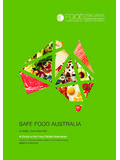


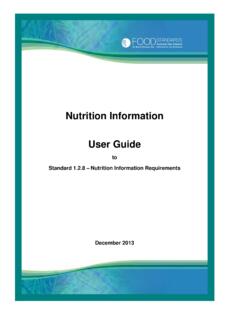
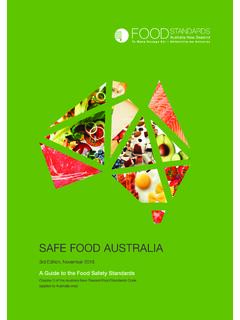






![arXiv:1704.00051v2 [cs.CL] 28 Apr 2017](/cache/preview/b/4/e/8/7/0/7/0/thumb-b4e870702c490839cae2d9092a2afede.jpg)

